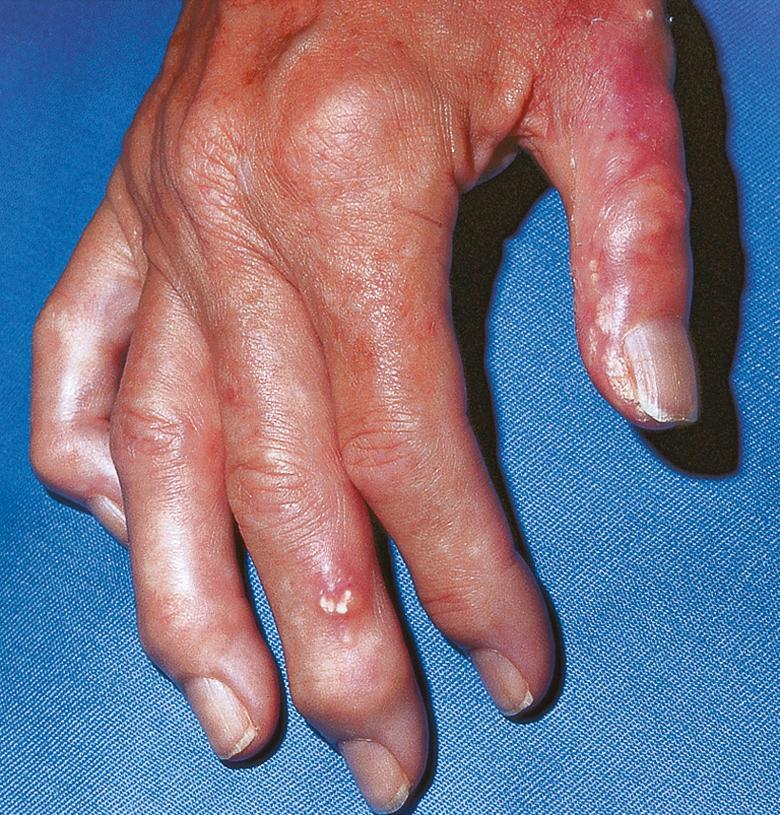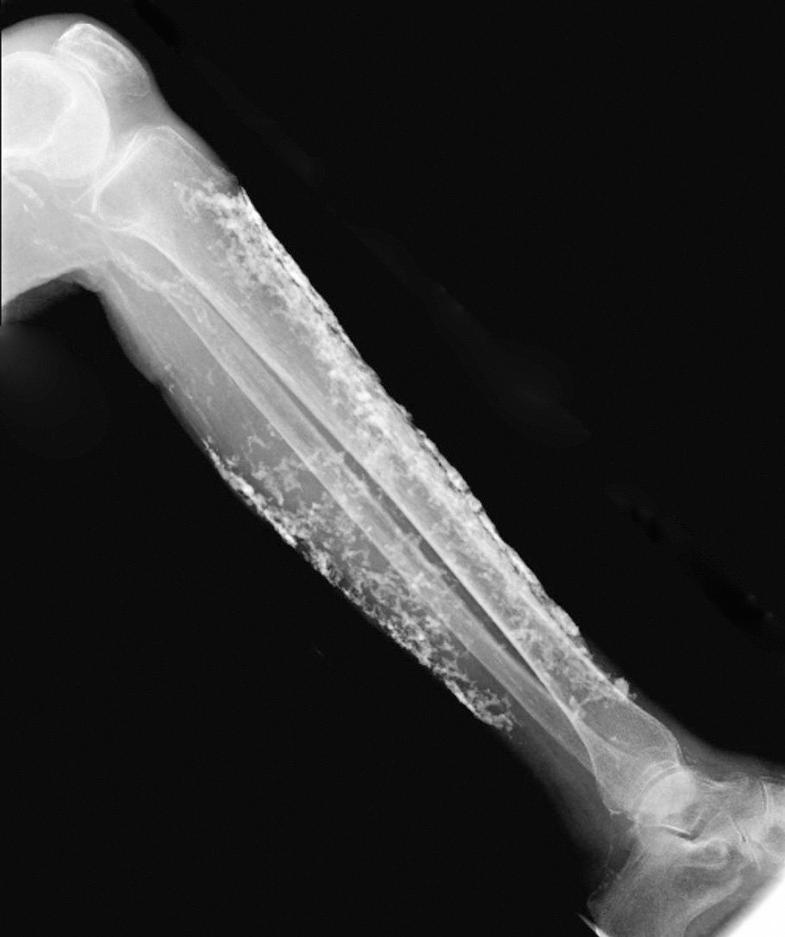Physical Address
304 North Cardinal St.
Dorchester Center, MA 02124
▪ Calcinosis cutis: cutaneous calcification ▪ Osteoma cutis: cutaneous ossification ▪ Calciphylaxis: calcific uremic arteriolopathy; calcifying panniculitis; uremic gangrene syndrome ▪ Subepidermal calcified nodule: solitary congenital nodular calcification; Winer's nodular calcinosis
Calcium regulates several key physiologic events in the skin, including epidermal proliferation, differentiation, and cell–cell adhesion
Disruption of normal calcium regulatory pathways can lead to calcification and/or ossification of the skin
Five major types of cutaneous calcification are seen: dystrophic , in which pre-existing damage to the skin results in calcium deposits; metastatic , where systemic metabolic disorders lead to calcium deposits in the skin and often other tissues; iatrogenic , as a result of medical therapy or testing; idiopathic , in which no cause can be identified; and mixed , a combination of metastatic and dystrophic
In cutaneous ossification, there is deposition of calcium and phosphorus as hydroxyapatite crystals within a protein matrix; it can occur in conjunction with calcification or primarily in a number of genetic syndromes
For correct classification of calcifying disorders, an evaluation of calcium-phosphate metabolism and an examination for associated systemic abnormalities are required
Treatment of calcifying disorders is difficult. Correction of any associated disorder, such as hyperparathyroidism, is essential to prevent further calcification. Efficacy of agents that modify calcium metabolism is based primarily upon case series. Surgical excision may be useful in circumscribed disease that interferes with function
Calcium plays a vital role in regulating key physiologic events in many tissues, including the skin. In the epidermis, calcium shares in the control of major functions, including proliferation, differentiation, and cell–cell adhesion. Control of intra- and extracellular calcium concentrations and maintenance of gradients are essential for its regulatory role. When factors that regulate calcium in the skin are disrupted, by either local or systemic events, cutaneous calcification or ossification as well as acantholysis and dyskeratosis can develop.
Calcification arises from the deposition of amorphous, insoluble calcium salts, while ossification results from deposition of calcium and phosphorus in a proteinaceous matrix as hydroxyapatite crystals. Ossification may follow pre-existing calcification in the skin, but in most disorders one form of calcium deposition predominates. Each of the calcifying and ossifying disorders of the skin is rare, but as an aggregate finding calcium deposition within the skin is not uncommon.
Calcifying disorders of the skin are generally divided into five broad categories: dystrophic, metastatic, idiopathic, iatrogenic, and mixed calcification . Dystrophic calcification occurs in the setting of localized tissue damage, without an underlying metabolic abnormality in calcium regulation. Theoretically, dystrophic calcification occurs because the underlying disease process damages cell membranes, allowing calcium influx and subsequent intracellular crystallization. Alternatively, the acidity that accompanies cell damage may disrupt normal processes that inhibit calcification. In contrast, metastatic calcification occurs in normal tissue when there is dysfunction of calcium regulatory systems. When no known local or systemic factors can be identified, the calcification is categorized as idiopathic , and that related to medical therapy or testing is iatrogenic . Mixed calcification arises when metastatic calcification due to an underlying metabolic abnormality acts as a trigger for dystrophic calcification.
Dystrophic calcification may be seen in any of the autoimmune connective tissue diseases (AI-CTDs), but it is most common in childhood dermatomyositis and in the CREST form of systemic sclerosis. As a comparison, cutaneous calcification develops in 10–20% of patients with adult dermatomyositis, whereas it occurs in ~50–70% of children with the disease (see Fig. 42.8 ) . The presence of dermatomyositis-associated calcinosis correlates with longer disease duration, fingertip ulceration, and anti-NXP-2 autoantibodies, while a negative correlation exists with anti-transcriptional intermediary factor 1-γ antibodies . Small deposits may occur in the skin or larger firm masses may begin in the muscle groups most severely affected by the disease. The most frequently involved sites are the elbows, knees, buttocks, and shoulders. Extrusion of calcium through the skin causes significant morbidity with pain and secondary infection.
In calcinosis universalis, the most severe form of dystrophic calcification, there is diffuse involvement with sheet-like masses of calcium. Calcification occurs along fascial planes, often leading to severe functional impairment. Aggressive treatment of dermatomyositis with immunosuppressive agents and/or IVIg may be warranted to try to limit this serious complication (see Ch. 42 ). However, once calcification has developed, the effectiveness of these therapies can be quite variable.
The CREST ( c alcification, R aynaud phenomenon, e sophageal dysmotility, s clerodactyly, and t elangiectasia) variant of systemic sclerosis is the other AI-CTD in which cutaneous calcification is frequently seen. Calcification is usually less severe than in dermatomyositis and is usually restricted to the hands and upper extremities ( Fig. 50.1 ); it is also seen over bony prominences and tendons. Extrusion of white chalky material is sometimes followed by localized ulceration, often at sites of trauma such as the digits. Calcinosis universalis can occur in systemic sclerosis, but much less frequently than in dermatomyositis.

Dystrophic calcification has occasionally been reported in chronic cutaneous, acute systemic, and subacute cutaneous lupus erythematosus as well as generalized morphea ( Fig. 50.2 ) . Calcification may also occur within lesions of lupus panniculitis. In systemic lupus erythematosus, calcification is most often an asymptomatic radiologic finding.

Therapies for dystrophic calcification include a low calcium and phosphate diet, aluminum hydroxide, and bisphosphonates, although no controlled trials have convincingly shown clinical improvement. In case reports and small series of patients, colchicine, probenecid, and sodium thiosulfate have demonstrated some efficacy. For small deposits (<3mm), application of topical sodium thiosulfate (12.5 mg/ml compounded 1:1 with petrolatum applied daily) can lead to resolution, while larger lesions may respond to intradermal injections (12.5 mg/ml, 0.1–1 ml every 3 to 6 weeks). Long-term treatment with diltiazem was reported to decrease the size of calcium deposits, presumably through its effect on calcium transport into cells . However, months to years of treatment may be required for extensive calcification. Surgical excision is appropriate in selected patients with localized masses that are painful or interfere with function, but recurrence can occur.
Any lobular panniculitis may develop focal dystrophic calcification, including pancreatic panniculitis, lupus profundus, and subcutaneous fat necrosis of the newborn (see Ch. 100 ). In the latter, the calcium deposits are small and are most easily noted radiologically; occasionally, more widespread deposits may be seen .
A number of genetic disorders may be accompanied by cutaneous calcification, including pseudoxanthoma elasticum (PXE; see Ch. 97 ). The coexistence of typical elastic fiber calcification along with small discrete foci of cutaneous calcification or ossification has been reported . PXE results from inactivating mutations in ABCC6 which encodes a membrane transporter system . ABCC6 directly mediates the sinusoidal release of ATP from the liver, which is then converted to AMP and inorganic pyrophosphate (PPi) within the liver vasculature . PPi normally prevents the matrix calcification that is thought to create the findings in PXE . In addition, serum levels of fetuin-A, another major anti-mineralization protein, are significantly reduced in PXE patients . These factors, combined with impaired carboxylation of the inhibitor matrix Gla protein, may allow for increased responsiveness to pro-calcifying stimuli and unchecked calcification of elastic fibers in affected tissues .
Ehlers–Danlos syndrome encompasses multiple disorders in which genetic mutations lead to abnormal collagen synthesis, metabolism, or function (see Ch. 95 ). Patients develop hard subcutaneous nodules known as spheroids or spherules over bony prominences, which are thought to represent herniated fat lobules that have become calcified (see Ch. 97 ). It is also possible that minor trauma results in scar tissue which then becomes a focus for dystrophic calcification . Of note, similar calcifications can occur within the breast in these patients and their detection by mammography may lead to false-positive radiographic findings for breast carcinoma.
Dystrophic calcification may also be seen in patients with porphyria cutanea tarda (PCT; see Ch. 49 ). It occurs most often in patients with longstanding disease who develop sclerodermoid changes and secondary calcification within these areas . As with the other lesions of PCT, calcification appears most often in the head and neck region or on the dorsal surface of the hands. Ulceration has also been reported, although rarely, in association with these lesions.
Other rare genetic syndromes in which cutaneous calcification may be seen include Werner syndrome and Rothmund–Thomson syndrome (see Ch. 63 ). Cerebral amyloid angiopathy , an autosomal dominant condition due to mutations in the gene encoding the amyloid precursor protein, can present with dementia, patchy leukoencephalopathy, hemorrhagic stroke, external carotid artery dysplasia, and occipital calcifications . Microcalcification of the dermal blood vessels may also be seen, and while the latter is asymptomatic, dermatologists might be called upon to biopsy the skin as a diagnostic measure.
Infections, particularly parasitic, can lead to dystrophic calcification. Calcified cysts form around larvae or worms, including Onchocerca volvulus and the tapeworm Taenia solium . Intrauterine herpes simplex viral infections may cause annular plaques of calcinosis cutis in newborns.
Become a Clinical Tree membership for Full access and enjoy Unlimited articles
If you are a member. Log in here